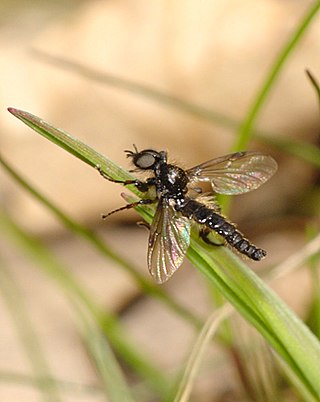
Bibionidae is a family of flies (Diptera) containing approximately 650–700 species worldwide. Adults are nectar feeders and emerge in numbers in spring. Because of the likelihood of adult flies being found in copula, they have earned colloquial names such as "love bugs" or "honeymoon flies".

Bibio marci or St. Mark's fly or hawthorn fly, is a species of fly from the family Bibionidae. It is found across much of Europe. Their common name comes from the fact that the adults usually emerge around St Mark's Day, 25 April.

Bibio, March flies or St. Mark's flies, is a genus of flies (Diptera).

Bibio pomonae, common name red-thighed St Mark's fly or heather fly, is a species of fly (Diptera) belonging to the family Bibionidae.

Bibio xanthopus, or yellow-footed March fly, is a species of March fly (Bibionidae) first identified by Wiedemann in 1828. It is one of the most common species of Bibio in North America. The body is black with pale colored pile and legs that are predominantly rufous. Females have black wings. The size of the species varies considerably, with wingspans ranging from 5.5 to 9.5 mm and body lengths ranging from 8 to 11 mm. The maggots, which feed on roots, are 10 mm in length with warty skin and a pair of posterior spiracles.

Bibio varipes is a species of fly in the family Bibionidae. It is found in the Palearctic.

Bibio longipes is a species of fly in the family Bibionidae. It is found in the Palearctic and the Nearctic.

Bibio lanigerus is a species of fly in the family Bibionidae. It is found in the Palearctic.

Bibio hortulanus, common name marchfly, is a species of fly from the family Bibionidae.

Bibio anglicus is a species of fly from the family Bibionidae.

Bibio ferruginatus is a species of fly from the family Bibionidae.
Bibio reticulatus is a species of fly in the family Bibionidae. It is found in the Palearctic.
Bibio rufithorax is a species of March fly in the family Bibionidae.
Bibio alienus is a species of March fly in the family Bibionidae.

Bibio vestitus is a species of March fly in the family Bibionidae.

Bibio articulatus is a species of march fly in the family Bibionidae. Its distinctive features are its dark exoskeleton that varries from black to a deep red, and red/orange legs.
Bibio holtii is a species of March fly in the family Bibionidae.
Bibio abbreviatus is a species of March fly in the family Bibionidae.
Bibio townesi is a species of March fly in the family Bibionidae.

Bibio albipennis is a species of March fly. It native to North America, where it is widespread.














